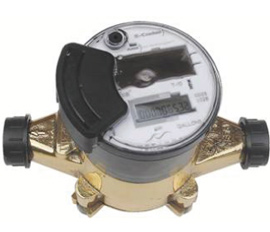Jim ‘Slim’ Mimlitz, SCADAmetrics
In order to minimize power consumption, the E-Coder register only activates its LCD when exposed to sunlight or another compatible light source, such as a flashlight. When the LCD is activated, the display alternates between meter totalization and flow rate. When inactive, the LCD is simply blank. While the ECoder is being interrogated by a SCADA device (eg “EtherMeter”) or AMR endpoint (eg “R900”), the LCD will go blank until the interrogation is complete — usually no more than 1 or 2 seconds at a time.
Note that if a flashlight is to be used for activating the LCD, the beam should be pointed directly at the solar cell at close range and from directly above. The beam should be held steady until the 9-digit totalization is displayed. In our experience, most flashlights and cell phone lights will work.
Looking for a flashlight recommendation? The Model 2000 “Super SabreLite” flashlight by Pelican is an excellent flashlight tailored for the Water Industry, as it has a sturdy outer shell and is rated for submersion. It features a Xenon-based bulb that is powered by three (3) C-Cell batteries and produces a strong light of 33 lumens/12,000 candelas. The Pelican 2000 may be purchased from Grainger as Part No. 4JC10, or from another Pelican supplier. A set of new Duracell C-Cell batteries are recommended. The replacement bulb is Pelican Part Number 2004, available as Grainger Part No. 4JC11. (Batteries are not included with this flashlight.)
The ECoder’s glass cover should be kept as clean as possible, as any residue or debris will weaken the light that is intended for the solar cell. If the ECoder register is interrogated automatically at short polling intervals (for instance, the EtherMeter’s default meter polling interval is every 15 seconds) — then the LCD may cease to display the meter totalization and flow-rate, even when activated with direct sunlight or a bright flashlight. If this poses a problem for the user, then the EtherMeter polling interval should be increased to 20 or 30 seconds. (eg. SET SAMPn 30) On the other hand, the user can always rely upon the EtherMeter’s LCD display, since it echos the flow-rate and an exact duplicate of the totalization from the ECoder.



I have a resident that uses the Neptune E-Coder R900 to measure the water they use for a sprinkler system to get a credit from their sewage bill for water not going into the sewage. Can you tell me how to read this? The first 3 numbers are above the black the next 3 numbers are in the white area with diagonal lines and then there is a . then two numbers. I need to know what numbers should be reported as to how many gallons they used through that meter.
Thank you
Toni,
The Neptune E-Coder provides a 9-digit reading of total consumption. The units could be Gallons, Cubic Feet, or Cubic Meters. In your case, you mentioned the meter is displaying Gallons.
You also mentioned that there are two numbers after the decimal point, hence the resolution is down to 1/100 of a gallon.
For example, if the meter were reading 1234567.89 — that equates to 1,234,567.89 Gallons.
Hope this helps!
-Jim
When interrogating a water meter it diminishes the battery life. By how much? Am I able to interrogate the meter 20 times and still get 20 years out of the battery?
Hi my name is John Crawford we have Neptune meters and we are getting set up to be able to interrogate them with the NGO app how badly does it affect the meters battery. Could we read them twenty times and still get twenty years
Does the E-Coder)R900i provide rate of flow information?
The E-Coder)R900i provides a localized read out of average flow rate every six seconds on the LCD display. Every six seconds the
word “RATE” will flash and the flow rate will be displayed for two seconds on 5
⁄8 – 2” meters.
But what are the units? litres per second?
To test the Flow Rate indicator, I turned my bathroom faucet on at a very low rate. However, the Flow Rate in my T-10 5/8″ meter registered 0.00 for many flashes. only after a minute or so did it register .111. Then, back to 0.00 for many flashes. Is that normal?
Hello Russ, Our EtherMeter instrumentation provides a rate-of-flow calculation that is based on delta-total / delta-time, and in my past observations, always provides a more accurate rate-of-flow figure than that displayed on the E-Coder register.
John Crawford, The regular Neptune E-Coder register does not have an internal battery, and therefore it can be interrogated an unlimited number of times without adverse effect.
There are other brands that utilize an internal battery, and it is my understanding that the life span of some (perhaps not all) are affected by how often the meter is electronically interrogated.
I recommend checking with each manufacturer for detailed engineering specs.
My residential home has the Neptune E-coder R900 and have had a recent reading that showed I used 24,500 gallons in a month witch I disputed with my local utility company. For the past 15yrs I average 3500 gal. Per month.
My question is; Can a local utility company manipulate the Neptune e- coder r900 from remote location.
Can they add gallons to the meter without water flowing thru the meter?
When first installed is the unit set at all zeros ?
And does the digital display keep adding up every month ( like an odomoter ) or does it reset to zeros every month?
How does the water company calculate the first bill if part of the month of installation was with a previous meter setup ?